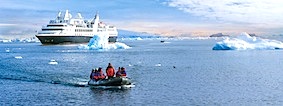Leading cruise operator Silversea has announced Silver Galapagos as the name for its second small-sized expedition ship, which is currently sailing as the Galapagos Explorer II. 
The new name signals the company’s intent to maintain a consistent level of elegance throughout its fleet and will take effect following a full refurbishment in September 2013. The hull of the all-suite, 100-guest vessel has already been painted the same dark blue as Silver Explorer, the company’s other expedition ship.
Silver Galapagos will be the only luxury expedition ship offering socially and environmentally responsible ecotourism to the Galápagos archipelago, a UNESCO World Heritage Site. This important distinction enables Silversea to broaden its portfolio of expedition cruises tailored to tap into the rising interest in green tourism.
Silversea will start selling its 2013 Galápagos programme in November 2012, offering two new seven-day itineraries. These will begin operating in late September 2013, sailing Saturday to Saturday on a round-trip voyage from Baltra Island. The two voyages will be as follows:
Saturday to Saturday – round-trip from Baltra Island: Silver Galapagos will trace a path across the western, southern and eastern islands, including Santiago, Bartolomé, Isabela, Fernandina, Floreana, San Cristóbal, and Santa Cruz.
Saturday to Saturday – round-trip from Baltra Island: Silver Galapagos will encompass the northeast, central and southeast islands of Santa Cruz, Genovesa, Seymour Norte, San Cristóbal, Española, and Plazas Sur.
This new schedule will offer adventurous travellers the chance to discover a wild, pristine paradise that has long been regarded as a natural laboratory of evolution. Through complimentary expeditions, guided by an experienced expedition team (certified by the Galápagos National Park Service), Silversea’s guests will be able to experience up-close encounters with an abundance of wildlife, including sun-basking land iguanas, giant tortoises, blue- and red-footed boobies, colourful marine iguanas, sea lions, penguins and Darwin’s famous finches.
The programme will also offer guests the opportunity to swim and snorkel in tranquil clear waters, witness unique highland ecosystems, hike through lush mangrove forests and across volcanic fields, explore natural lava tunnels, watch for wild flamingos (in season), read cave inscriptions from the 1800s, and learn about conservation efforts at the Charles Darwin Research Station.





